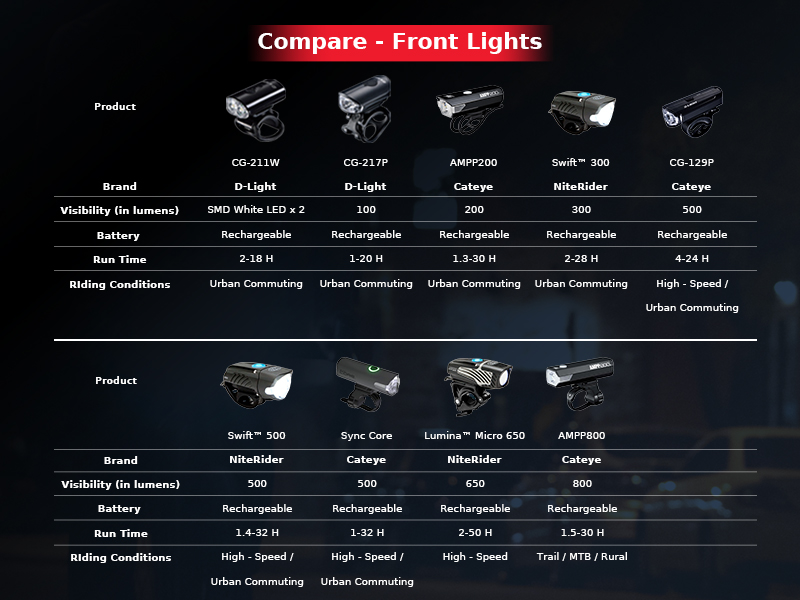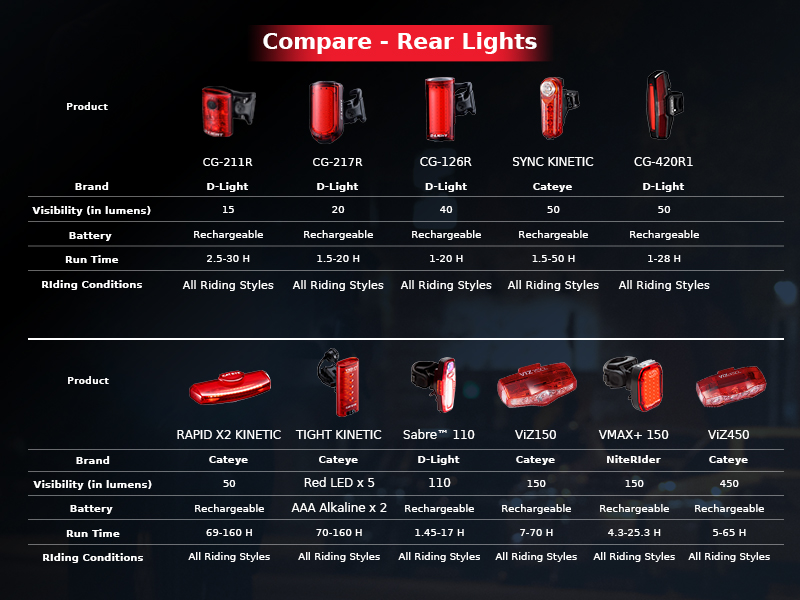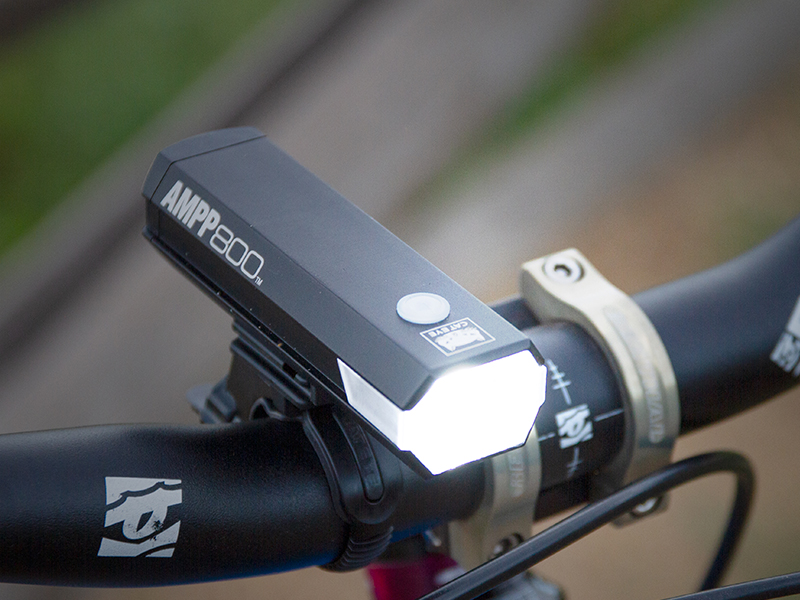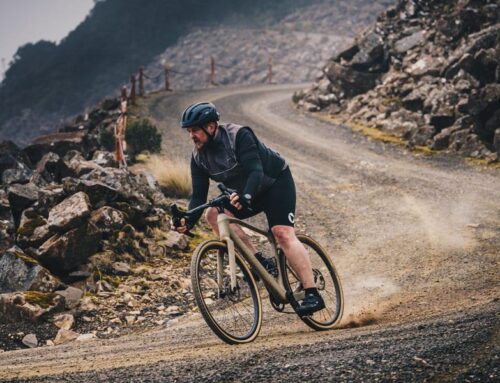When it comes to cycling, safety should always be your top priority. Whether you’re commuting in the city, racing down rural paths, or taking leisurely rides, one thing is crucial—visibility. The right bike lights not only illuminate your path but also make you visible to others, ensuring safety on the road. With the vast array of options available, it can be overwhelming to choose the best one. That’s why we’ve compiled this guide to the best bike lights of 2024, tailored to different riding conditions and styles, so you can ride with confidence, day or night.
Front Lights for Different Riding Conditions

1. D-light CG211W
Specifications:
- Weight: 19.2g
- Visibility: SMD White LED x 2
- Battery: Rechargeable
- Mounting Position: Handlebar/Helmet
- Run Time: 18h (flashing), 7h (daytime)
Pros:
- Extremely lightweight, making it ideal for helmet mounting.
- Long run time, especially in flashing mode, ensures you stay visible for extended periods.
Cons:
- Limited brightness, making it less suitable for very dark or rural areas.
2. D-light CG217P
Specifications:
- Weight: 16.2g
- Visibility: 100 lumens
- Battery: Rechargeable
- Mounting Position: Handlebar/Helmet
- Run Time: 15h (daytime flashing), 5h (high beam)
Pros:
- Compact and lightweight with higher brightness compared to the CG211WR.
- Versatile mounting options for different riding styles.
Cons:
- Lower battery life on high beam mode compared to other models.
3. Cateye AMPP200
Specifications:
- Weight: 62g
- Visibility: 200 lumens
- Battery: Rechargeable
- Mounting Position: Handlebar/Helmet
- Run Time: 9h (medium beam), 28h (flashing)
Pros:
- Solid brightness at 200 lumens, suitable for urban commuting.
- Excellent run time, especially in flashing mode.
- Using Type-C
Cons:
- Slightly heavier than other front lights in the same category.
4. Niterider Swift 300
Specifications:
- Weight: 82.6g
- Visibility: 300 lumens
- Battery: Rechargeable
- Mounting Position: Handlebar/Helmet
- Run Time: 12h (flashing), 5h (medium beam)
Pros:
- High visibility with 300 lumens, perfect for low-light conditions.
- Durable and reliable, making it ideal for regular use.
Cons:
- Heavier and bulkier than some other models, which may be a drawback for helmet mounting.
5. D-light CG129P
Specifications:
- Weight: 66.4g
- Visibility: 500 lumens
- Battery: Rechargeable
- Mounting Position: Handlebar/Helmet
- Run Time: 32h (flashing), 8h (high beam)
Pros:
- Powerful 500 lumens light, making it suitable for high-speed commuting and rural areas.
- Impressive run time, ensuring consistent performance.
Cons:
- Heavier than other lights, which might affect handling on rough terrain.
6. Niterider Swift 500
Specifications:
- Weight: 82g
- Visibility: 500 lumens
- Battery: Rechargeable
- Mounting Position: Handlebar/Helmet
- Run Time: 24h (flashing), 10h (medium beam)
Pros:
- High brightness at 500 lumens, perfect for fast-paced rides in dark conditions.
- Versatile mounting options.
Cons:
- Heavier design, which may not be suitable for all riders.
7. Cateye Sync Core
Specifications:
- Weight: 94g
- Visibility: 500 lumens
- Battery: Rechargeable
- Mounting Position: Handlebar/Helmet
- Run Time: 12.3h (flashing), 9h (medium beam)
Pros:
- Robust build quality with advanced features like app connectivity.
- High lumen count for excellent visibility in various conditions.
- Using type-c
Cons:
- The app connectivity feature might not be necessary for all riders, adding extra cost.
8. Niterider Lumina Micro 650
Specifications:
- Weight: 130g
- Visibility: 650 lumens
- Battery: Rechargeable
- Mounting Position: Handlebar/Helmet
- Run Time: 20h (daytime flashing), 7h (medium beam)
Pros:
- Extremely powerful 650 lumens, ideal for off-road and rural rides.
- Long run time in flashing mode.
Cons:
- Bulky and heavy, making it less ideal for casual commuters.
9. Cateye AMPP 800
Specifications:
- Weight: 136.6g
- Visibility: 800 lumens
- Battery: Rechargeable
- Mounting Position: Handlebar/Helmet
- Run Time: 50h (walk mode), 4h (high beam)
Pros:
- Incredibly bright with 800 lumens, perfect for any riding condition.
- Long-lasting battery life in walk mode, suitable for extended trips.
- Using Type-C
Cons:
- Heavier than most, which may not suit all types of riders.
Read also: Ideal Lumens Brightness for Choosing Bike Lights – Rodalink
Rear Lights for All Riding Conditions

1. D-light CG 211R
Specifications:
- Weight: 19.2g
- Visibility: 15 lumens
- Battery: Rechargeable
- Mounting Position: Seatpost/Seatstay
- Run Time: 18h (flashing), 7h (steady)
Pros:
- Extremely lightweight and compact, making it ideal for minimalists.
- Long run time, especially in flashing mode, for extended visibility.
Cons:
- Lower brightness at 15 lumens, which may not be sufficient for very dark or busy areas.
2. D-light CG 217R
Specifications:
- Weight: 16.2g
- Visibility: 20 lumens
- Battery: Rechargeable
- Mounting Position: Seatpost/Seatstay
- Run Time: 15h (daytime flashing), 5h (steady)
Pros:
- Lightweight and easy to mount, ideal for urban commuting.
Cons:
- Shorter battery life in steady mode compared to other models.
3. D-light CG 126R
Specifications:
- Weight: 40g
- Visibility: 40 lumens
- Battery: Rechargeable
- Mounting Position: Seatpost/Seatstay
- Run Time: 32h (flashing), 8h (steady)
Pros:
- Excellent battery life, especially in flashing mode.
Cons:
- Slightly heavier compared to other lightweight options.
4. Cateye Sync Kinetic
Specifications:
- Weight: 43g
- Visibility: 50 lumens
- Battery: Rechargeable
- Mounting Position: Seatpost/Seatstay
- Run Time: 30h (flashing), 5h (steady)
- Special Features: Kinetic mode activates a brighter light when decelerating.
Pros:
- Innovative kinetic mode for enhanced safety when braking.
- Sync capability with other Cateye Sync lights for coordinated visibility.
- Usng type-c
Cons:
- Moderate brightness at 50 lumens may not be sufficient for all conditions.
5. D-light 420R1
Specifications:
- Weight: 54g
- Visibility: 50 lumens
- Battery: Rechargeable
- Mounting Position: Seatpost/Seatstay
- Run Time: 20h (flashing), 6h (steady)
Pros:
- Solid battery life for long rides.
Cons:
- Bulkier design compared to other rear lights, which may affect aesthetics.
6. Cateye Rapid X2 Kinetic
Specifications:
- Weight: 31g
- Visibility: 50 lumens
- Battery: Rechargeable
- Mounting Position: Seatpost/Seatstay
- Run Time: 30h (flashing), 5h (steady)
- Special Features: Kinetic mode for deceleration.
Pros:
- Slim design with excellent side visibility.
- Kinetic mode enhances safety during braking.
- Using Type-C
Cons:
- Limited brightness at 50 lumens, better suited for well-lit areas.
7. Cateye Tight Kinetic
Specifications:
- Weight: 53g
- Visibility: 20 lumens
- Battery: Non-rechargeable (replaceable battery)
- Mounting Position: Seatpost/Seatstay
- Run Time: 100h (flashing), 50h (steady)
Pros:
- Long battery life with replaceable batteries, great for long-distance rides.
- Kinetic mode for added safety.
Cons:
- Non-rechargeable.
8. Niterider Sabre 110
Specifications:
- Weight: 28g
- Visibility: 110 lumens
- Battery: Rechargeable
- Mounting Position: Seatpost/Seatstay
- Run Time: 12h (flashing), 6h (steady)
Pros:
- Brightness at 110 lumens offers good visibility.
- Lightweight and compact, easy to mount and carry.
Cons:
- Shorter run time compared to other lights, especially in steady mode.
9. Cateye Viz150
Specifications:
- Weight: 34g
- Visibility: 150 lumens
- Battery: Rechargeable
- Mounting Position: Seatpost/Seatstay
- Run Time: 20h (flashing), 5h (steady)
Pros:
- High brightness with excellent side visibility.
- Compact design with a reliable mounting system.
Cons:
- Shorter battery life in steady mode compared to other options.
10. Niterider VMAX + 150
Specifications:
- Weight: 48g
- Visibility: 150 lumens
- Battery: Rechargeable
- Mounting Position: Seatpost/Seatstay
- Run Time: 18h (flashing), 5h (steady)
Pros:
- High brightness for enhanced visibility.
- Durable design, suitable for all weather conditions.
Cons:
- Heavier than some other rear lights, which may not suit all cyclists.
11. Cateye ViZ 450
Specifications:
- Weight: 56g
- Visibility: 450 lumens
- Battery: Rechargeable
- Mounting Position: Seatpost/Seatstay
- Run Time: 60h (flashing), 2h (high steady)
Pros:
- Extremely bright at 450 lumens, ideal for all riding conditions.
- Multiple modes with a long battery life in flashing mode.
Cons:
- Heavier and bulkier, making it less ideal for minimalist setups.
Conclusion: Choosing the Best Light for Your Ride
Whether you’re navigating city streets, cruising through suburban neighborhoods, or tackling challenging rural terrains, having the right bike light can make all the difference. Investing in a quality bike light isn’t just about enhancing your cycling experience—it’s about ensuring your safety on the road. Our top picks for 2024 include some of the best options available at Rodalink Singapore, ensuring you ride confidently and securely, day or night.
If you’re serious about cycling, don’t skip on this essential gear. Make sure you’re equipped with the right lights to stay safe and visible on all your rides.



